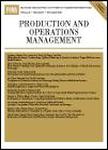-
作者:Gokalp, Elvan; Gulpinar, Nalan; Xuan Vinh Doan
作者单位:University of Warwick; University of Warwick
摘要:Stem-cell transplantation is the last chance for patients of various blood-related diseases. Stem-cell donation centers admit patients in need of a stem-cell transplant and search for a perfect match between the patients and donors. The search process is time-consuming and requires expensive advanced equipments, in particular for DNA typing. In this study, we are concerned with a capacity planning problem in a network of stem-cell donation centers. The underlying optimization model integrates ...
-
作者:Miedaner, Felix; Sulz, Sandra
作者单位:University of Cologne; Erasmus University Rotterdam - Excl Erasmus MC; Erasmus University Rotterdam
摘要:Our study contributes to the scholarly debate whether organizational units should have a narrow focus and admit a homogeneous patient cluster or whether they should admit a pool of patient clusters. We investigate whether the benefits of increased volume through pooling patients outweigh the disadvantages of increased heterogeneity and pursue our analysis in the context of neonatal care. Our empirical studies relies on 4020 patient episodes collected in 18 German neonatal intensive care units ...
-
作者:Jiang, Juncai; Wang, Yu
作者单位:Virginia Polytechnic Institute & State University; California State University System; California State University Long Beach
摘要:Ideation contests are commonly used across public and private sectors to generate new ideas for solving problems, creating designs, and improving products or processes. In such a contest, a firm or an organization (the seeker) outsources an ideation task online to a distributed population of independent agents (solvers) in the form of an open call. Solvers compete to exert efforts and the one with the best solution wins a bounty. In evaluating solutions, the seeker typically has subjective tas...
-
作者:Valletti, Tommaso; Wu, Jiahua
作者单位:Imperial College London
摘要:We consider a model where a monopolist can profile consumers in order to price discriminate among them, and consumers can take costly actions to protect their identities and make the profiling technology less effective. A novel aspect of the model consists in the profiling technology: the signal that the monopolist gets about a consumer's willingness-to-pay can be made more accurate either by having more consumers revealing their identities, or by spending larger amounts of money (e.g., on thi...

